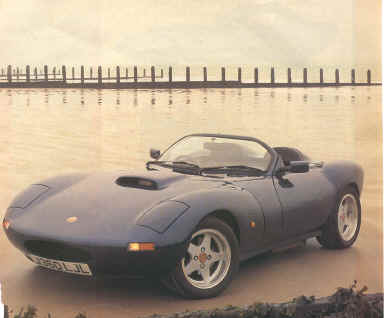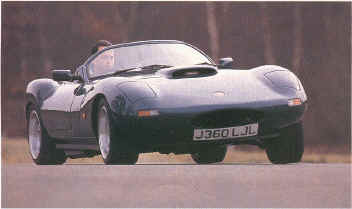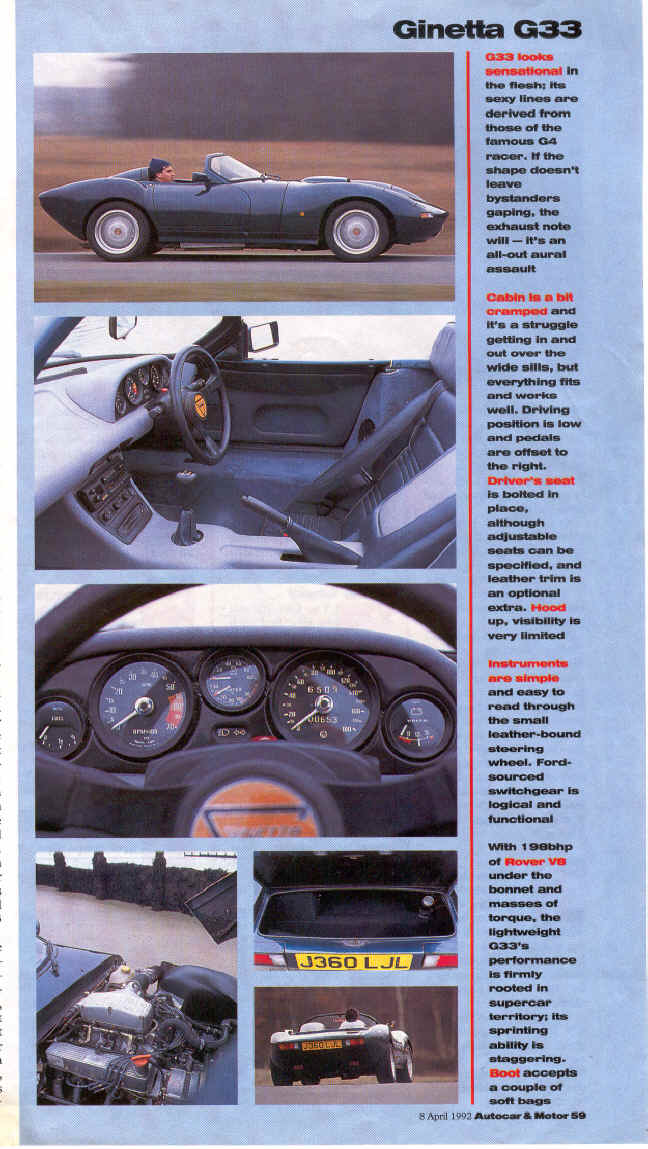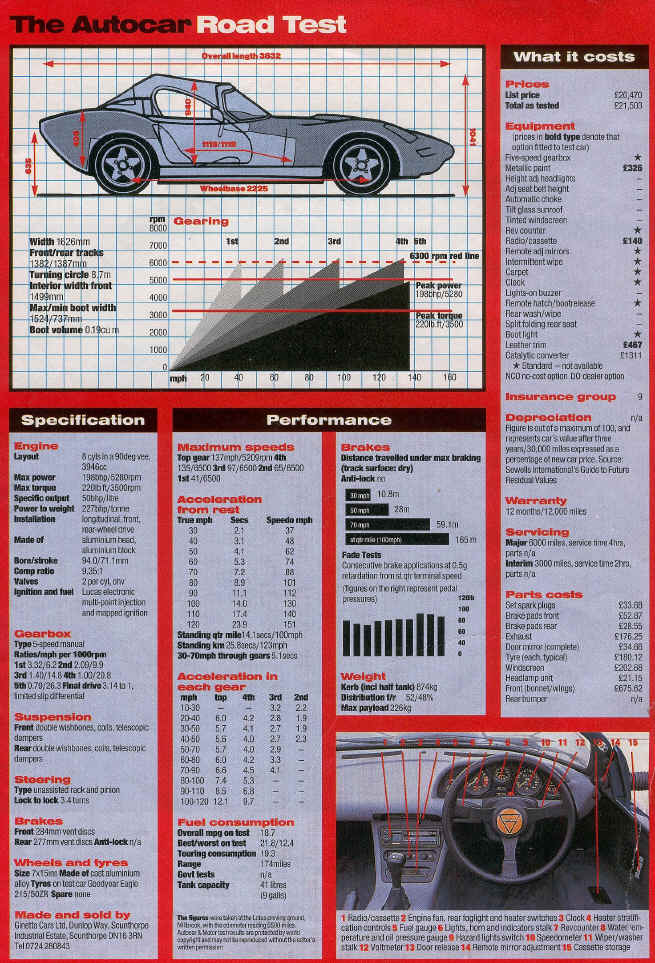Autocar July 1992

SOME MIGHT SAY that placing a 3.9-litre V8 engine beneath the bonnet of Ginetta's diminutive G33 smacks of overkill.
Ginetta, however, has every reason to be proud of its new creation, because there can be few more stunningly beautiful sports cars on sale today. And with the all-alloy, 3946cc Rover V8 engine developing 198bhp at 5280rpm and 220lb ft of torque at 3500rpm, there's big-time grunt behind the lithesome lines, too.
Priced at £20,470, the G33 looks fair value. Cast a wide net around other two-seater convertibles and you can't ignore the £14,981 Mazda MX-5 at one end or the £24,821 Morgan Plus 8 at the other. TVR's V8S costs £23,595, the Lotus Elan SE is £22,720 and a Caterham Seven HPC will set you back£18,255. And if you're in the market for this type of car, it's hard to ignore the Westfield SEiGHT at £20,888 and the Marcos Mantula 3.9i Spyder at £28,026.
Performance *****
Weighing in at just 874kg - thats 246kg more than a caterham seven HPC but 149kg less than a Lotus Elan SE - and with a power-to-weight ratio of 227bhp per tonne (a Porsche 911 Turbo has 219bhp per tonne), acceleration is rooted in super car territory. Helped by copious low - down torque and a limited slip differential, the G33 scorches past 30mph in just 2.1secs, 60mph in 5.3secs and 100mph in 14secs dead. Blink and you've missed the standing quarter mile post, which flashes by just a tenth of a second later.
A better handle on the G33's staggering performance, though, is its 30- 70mph time through the gears - just 5.1 secs. Simply put, there are only a handful of cars that can sprint so effectively. Not surprisingly, one of them is the more powerful, but slightly heavier TVR V8S, which offers all but identical performance. Blackpool's bomber is just a tenth quicker to 60mph- a margin it maintains over the standing quarter mile, too - but from 30- 70mph the cars can't be split. Bring on the big guns and the Ginetta would even pip such exalted sports cars as the Ronda NSX and the Ferrari 348tb up to around 80mph. Only the kings of the power-to-weight ratio - the Caterham Seven HPC and the Westfield SEIGHT - significantly better the which the Caterham completes in a rapid 4.6secs and the Westfield in an eye - watering 3.6secs. The real revelation of having 2201b ft of torque in the Ginetta's lightweight body is its talent for swift and therefore ultimately safe over taking. The increments of 30-50mph in fourth and 50-70mph in fifth are completed in just 4.lsecs and 5.7secs respectively. Both times are devastatingly fast - easily fast enough to shut down all the G33's chosen rivals, apart from the Caterham, which posts nigh- on identical times.
We recorded a top speed of 137 mph around Millbrook's banked bowl - a slightly disappointing result, bearing in mind Genetta's assertion that it will do I50mph. Apparently the standard engine management chip cuts in the rev limiter prematurely in fifth gear, thereby stifling top speed. It is due to be changed. Certainly the engine revved with verve to its 6S00rpm cut-out in the other four gears, so l5Omph is on the cards with the new chip.
Away from the test track, the G33 feels every bit as eager as its figures suggest. Once accustomed to the firmness of the accelerator and brake pedals, the G33 is surprisingly easy to drive. The chubby gear lever sprouting from the standard Rover SD 1 gearbox requires a firm hand but snicks positively between its wide- spaced ratios to provide a seamless band of potent acceleration. We think this is the best a V8 Rover engine has ever sounded. The exhaust note ranges from a deep- chested woofle, pop and bang on overrun to full Can- Am car roar from 4000rpm upwards.
Fuel economy ***
18.7mpg for our overall return left us pleasantly surprised. Our pre-set test route produced 19.3mpg, which would allow a theoretical range of about 174 miles from the nine-gallon tank. A Caterham Seven HPC will cover a similar distance and a Lotus Elan about 205 miles. Driven in a spirited manner, expect the Ginetta to return about 17.0mpg.
Handling **
We drove a prototype G33 last year and expressed concern about that car's stability over bumpy roads, so we were disappointed to find different but no less worrying characteristics in our test car. Ginetta traced the problem to the rear suspension bushes, which couldn't cope with the rigours of repeated test track standing starts. Ginetta's reputation was on the line here, so a second car from one of Ginetta's dealers was tried. This one worked fine, proving that the G33 can track straight and true. Drive the car over the type of roads it thrives on - undulating, twisty ones - and it soon earns your confidence. Let the Ginetta loose, while never letting it forget who's boss, and it can put an enormous smile on your face. And so it should. With double wishbones all round, koni dampers and 225/50 ZR15 tyres grip in the dry is tenacious, although a series of bumps may set the hard- sprung rear wheels hopping, and using too much throttle in low-gear corners will easily tear the rear tyres loose from the tarmac.

Stiffly sprung G33 is a demanding car to drive -but it's a whole lot of fun
On smoother roads, a clearer picture of the G33's handling emerges. It's one of extremely strong grip, mild understeer on the limit and as much oversteer as you can handle in clear second - gear corners. The unassisted rack and pinion steering is less directly geared than we would like and doesn't say enough about how the tyres are gripping for a car of this potential. And if matters do get out of hand, don't expect the Ginetta to forgive you. It is an out-and-out sports car and demands commitment to drive. Essentially it treats you with the same respect you show it. Abuse it and it bites.
Brakes ***
With no servo assistance you need to tread hard on the floor mounted brake pedal to slow the G33. Some 80lb of pressure is needed to hold .5g retardation. Not that the Sierra Cosworth brakes dont provide fine retardation - they do.
Ride ***
Potholes are the sworn enemy of this kind of car, thumping heavily through the glassfibre body-work. Although the Ginetta hardly rides comfortably, it makes a better fist of soaking up other bumps, especially over cat's-eyes. Damping control through dips is impressive, although the uncompromising ground clearance means the twin exhaust pipes tend to scrape the ground occasionally when pressing on.
At the wheel **
The Ginetta can be specified with ".adjustable seats, ---our test car had a fixed driver's seat, bolted as far back as possible. There's enough room for a six-footer, but the foot well is crowded and offset to the right. The main instruments are simple and uncluttered. Raise the roof (a super- human effort in itself, so fiddly is its structure) and visibility is dire. It is best to stow the hood and put up with the elements. The amplified exhaust note is a bonus.
Accommodation and comfort **
The Ginetta has few concessions to luxury, although there is a fan which we could only persuade to pump out warm air. Clambering aboard with the hood up requires a certain technique, such is the restricted space, the small door apertures and the low seating position. Storage space is better than expected: there is a lockable central cubby, a box to house cassettes and long, thin door bins. The boot provides a reasonable amount of luggage space - enough for two soft bags - but it also houses the petrol filler nozzle and lets drips fall on your luggage.
Noise ****
The exhaust note must be a strong selling point - it is exquisite. Top down, you hear little else but the wind at motorway speeds, but buffeting is commendably light. A degree of rumble is inevitable with such large tyres, but as the wind noise drowns out everything at speed, this is an academic point.
Build quality and safety **
Just two G33s come out of the Scunthorpe plant each week - a tiny number when you consider that Morgan produces 11 cars in that time. We therefore expected more of a hand-built feel to the car. But all the interior mouldings fit cleanly, the optional leather trim is tasteful and the Ford-sourced switch gear is logically situated and works well. As you might expect, one or two rattles and squeaks were evident, but they didn't get worse during our time with the car. Only the wildly inaccurate speedo- meter gave up after a long drive in the wet.
However, the hood leaks dreadfully in the lightest shower; if you are unlucky enough to drive the G33 after it's been left out over a wet night, take towels along for the ride. We would also like to see the catches that open the hood cover and boot put up slightly less of a fight before releasing. The optional metallic paint was well applied and had a deep, attractive lustre.
Plans are already in hand for getting the G33 Type Approved -a process that should be complete in about six months' time.
Equipment and value ***
Compare the G33 a Lotus Elan SE and it looks sparsely equipped. Do the same with a Caterham Super Seven HPC and it looks plush. The G33 has internally adjustable door mirrors, a remote boot release and a four or two- speaker stereo of the owner's choice and expense. We question the worth of the weather protection equipment, though. Two hundred miles in the wet proved that the hood and sidescreens are ineffective at keeping the water out. Both footwells were left sopping wet. A catalytic converter can be specified at extra cost.


